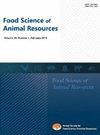筛选母猪与商品猪化学成分、品质及肌纤维特性的比较:基于肌纤维特性的猪肉品质关系
IF 3.7
3区 农林科学
Q2 FOOD SCIENCE & TECHNOLOGY
引用次数: 0
摘要
本研究旨在比较淘汰母猪和商品猪的化学成分、品质和肌纤维特性,探讨肌纤维特性的变化对猪肉品质的影响。比较了20头淘汰母猪(n = 20)和20头商品猪(n = 20)猪肉的近似组成、颜色、pH、保水能力(滴水损失和蒸煮损失)、蛋白质溶解度、总胶原蛋白含量和肌纤维特性。在屠宰母猪和商品猪的肉的近似组成、滴漏损失、蛋白质溶解度或总胶原蛋白含量方面,没有发现显著差异(p < 0.05)。而淘汰母猪猪肉呈红色,pH值较高(p<0.05)。这似乎是肌纤维数量和面积组成变化的结果(p<0.05)。淘汰母猪肉的保水能力也较好,蒸煮损失较小(p<0.05),这可能与肌纤维截面积增加有关(p<0.05)。由此可见,肌纤维成分影响猪肉品质;剔除母猪猪肉在烹饪时保留更多的水分,在加工过程中造成最小的物理损失,可以提供更多的加工适用性。本文章由计算机程序翻译,如有差异,请以英文原文为准。
Comparison of chemical composition, quality, and muscle fiber characteristics between cull sows and commercial pigs: The relationship between pork quality based on muscle fiber characteristics
This study aims to compare the chemical composition, quality, and muscle fiber characteristics of cull sows and commercial pigs, investigating the effect of changes in muscle fiber characteristics on pork quality. The proximate composition, color, pH, water-holding capacity (drip loss and cooking loss), protein solubility, total collagen content, and muscle fiber characteristics of cull sows (n = 20) and commercial pigs (n = 20) pork were compared. No significant differences were found between cull sows and commercial pigs in terms of proximate composition, drip loss, protein solubility, or total collagen content of their meat (p<0.05). However, cull sow pork exhibited a red color and a higher pH (p<0.05). This appears to be the result of changes in muscle fiber number and area composition (p<0.05). Cull sow meat also displayed better water-holding capacity as evident in a smaller cooking loss (p<0.05), which may be related to an increase in muscle fiber cross-sectional area (p<0.05). In conclusion, muscle fiber composition influences the pork quality; cull sow pork retains more moisture when cooked, resulting in minimal physical loss during processing and can offer more processing suitability.
求助全文
通过发布文献求助,成功后即可免费获取论文全文。
去求助
来源期刊

Food Science of Animal Resources
Agricultural and Biological Sciences-Animal Science and Zoology
CiteScore
6.70
自引率
6.70%
发文量
75
期刊介绍:
Food Science of Animal Resources (Food Sci. Anim. Resour.) is an international, peer-reviewed journal publishing original research and review articles on scientific and technological aspects of chemistry, biotechnology, processing, engineering, and microbiology of meat, egg, dairy, and edible insect/worm products.
 求助内容:
求助内容: 应助结果提醒方式:
应助结果提醒方式:


